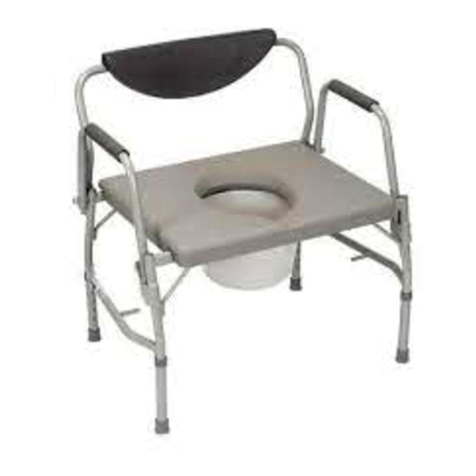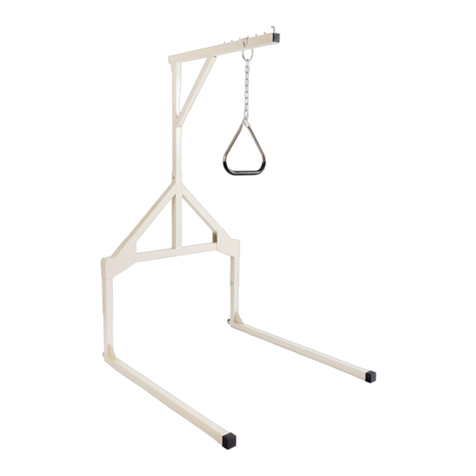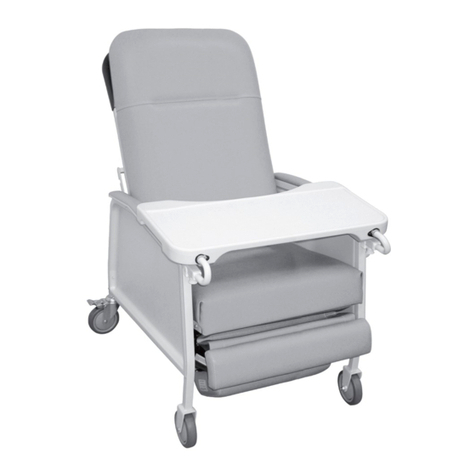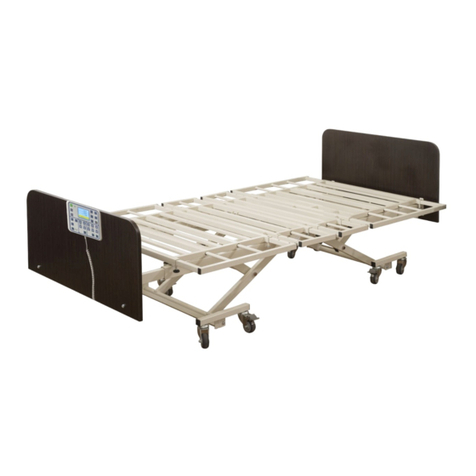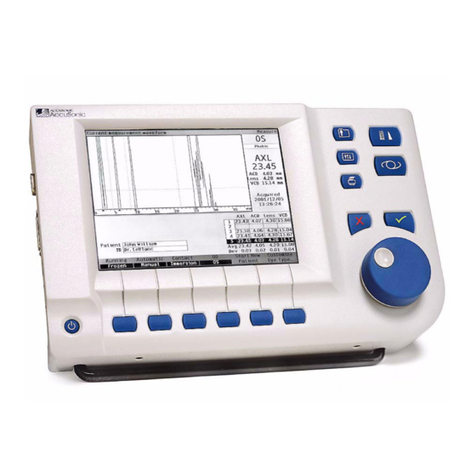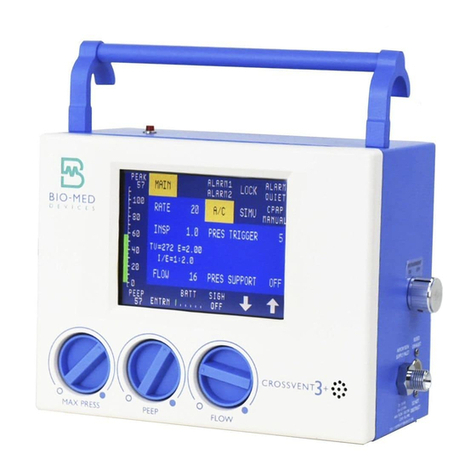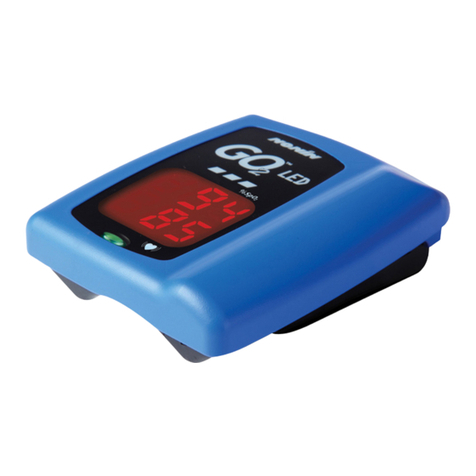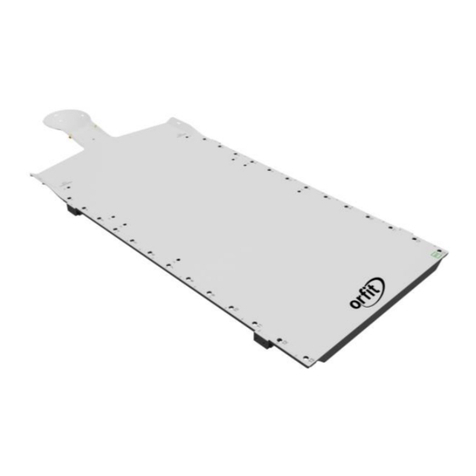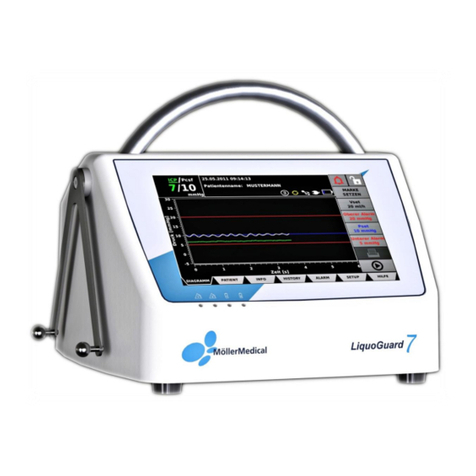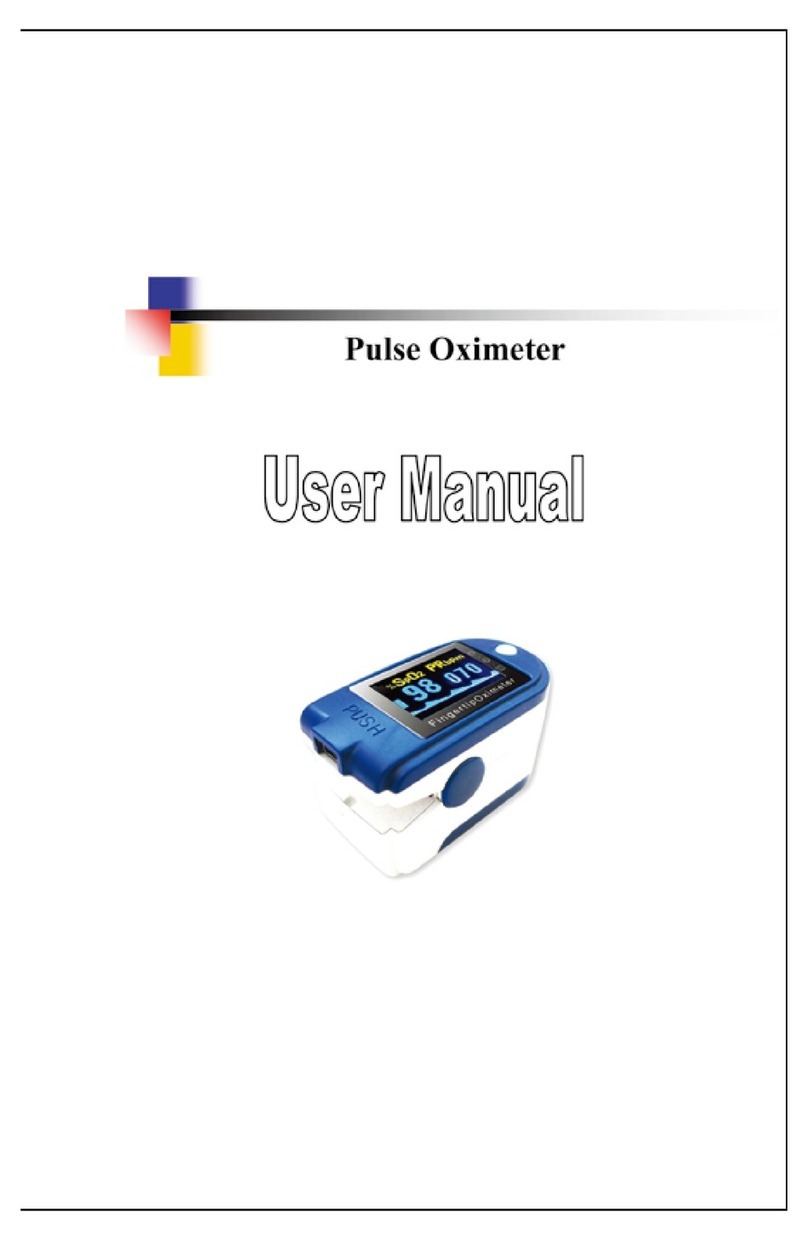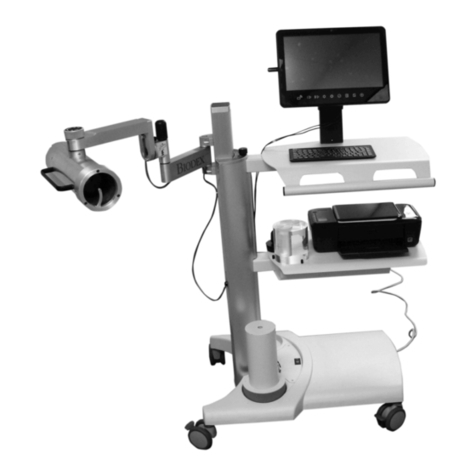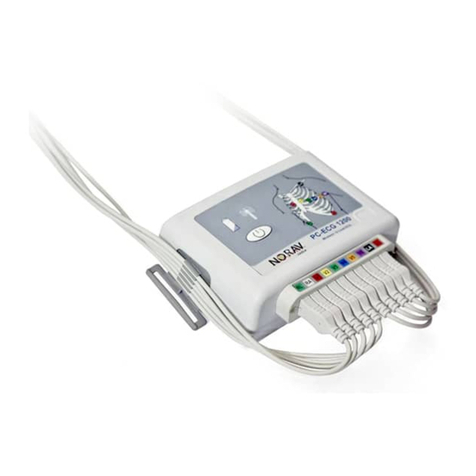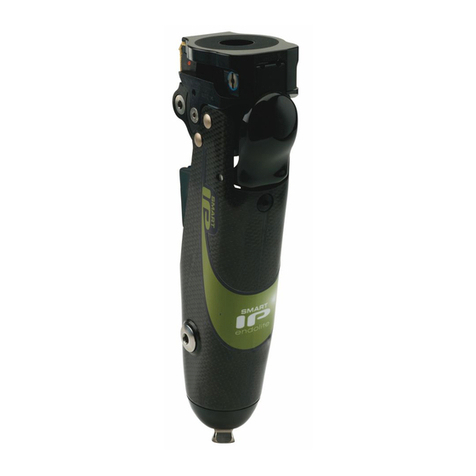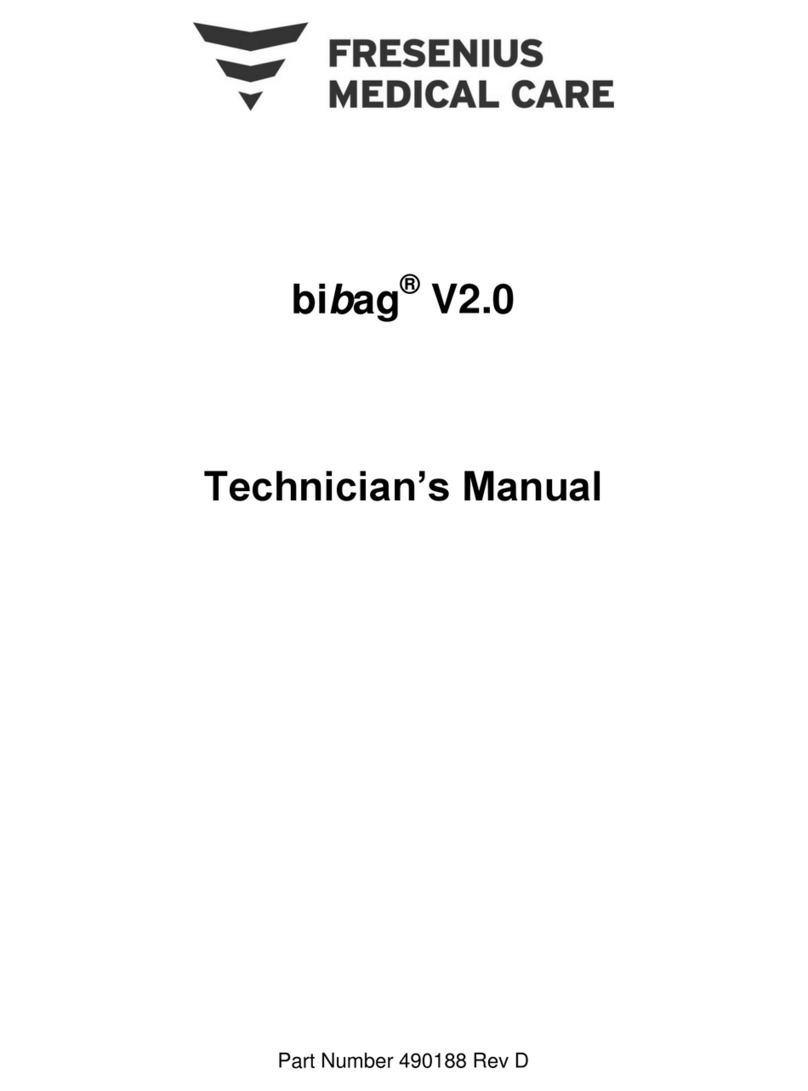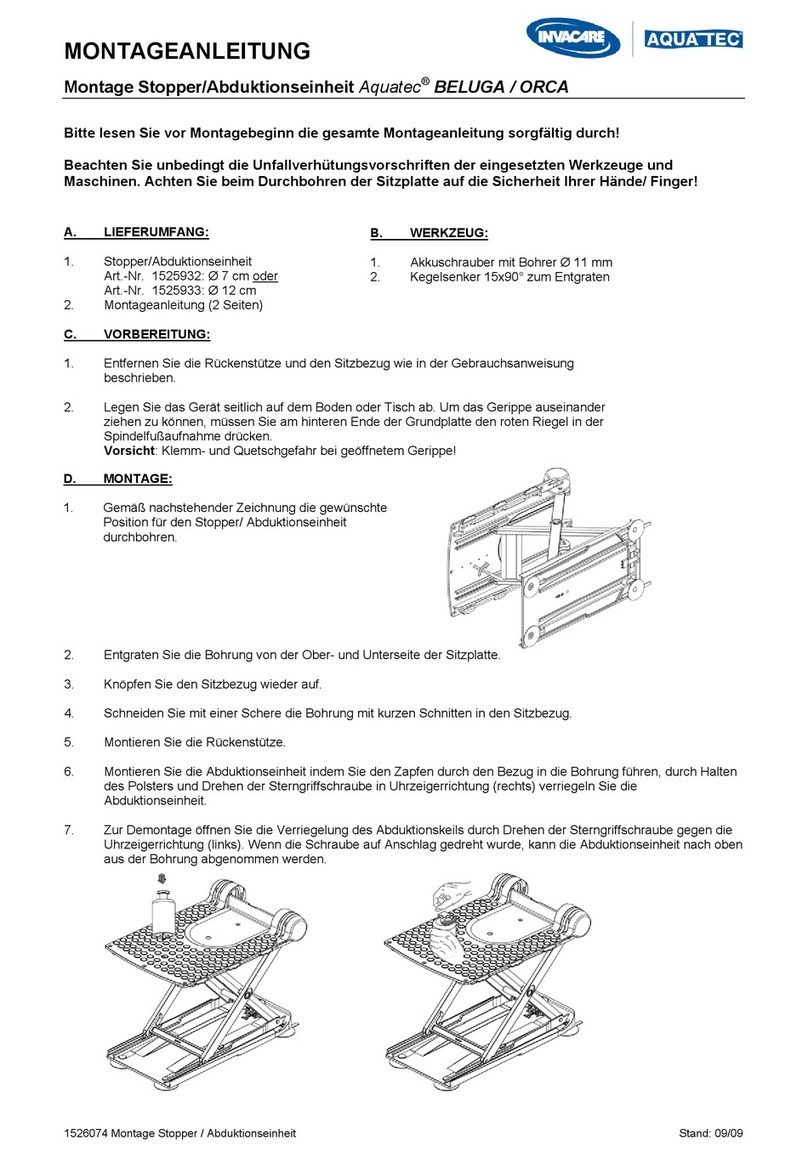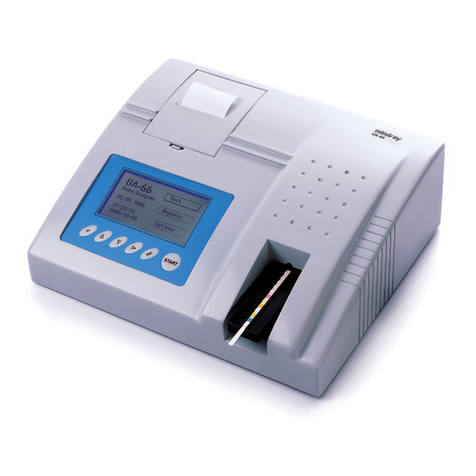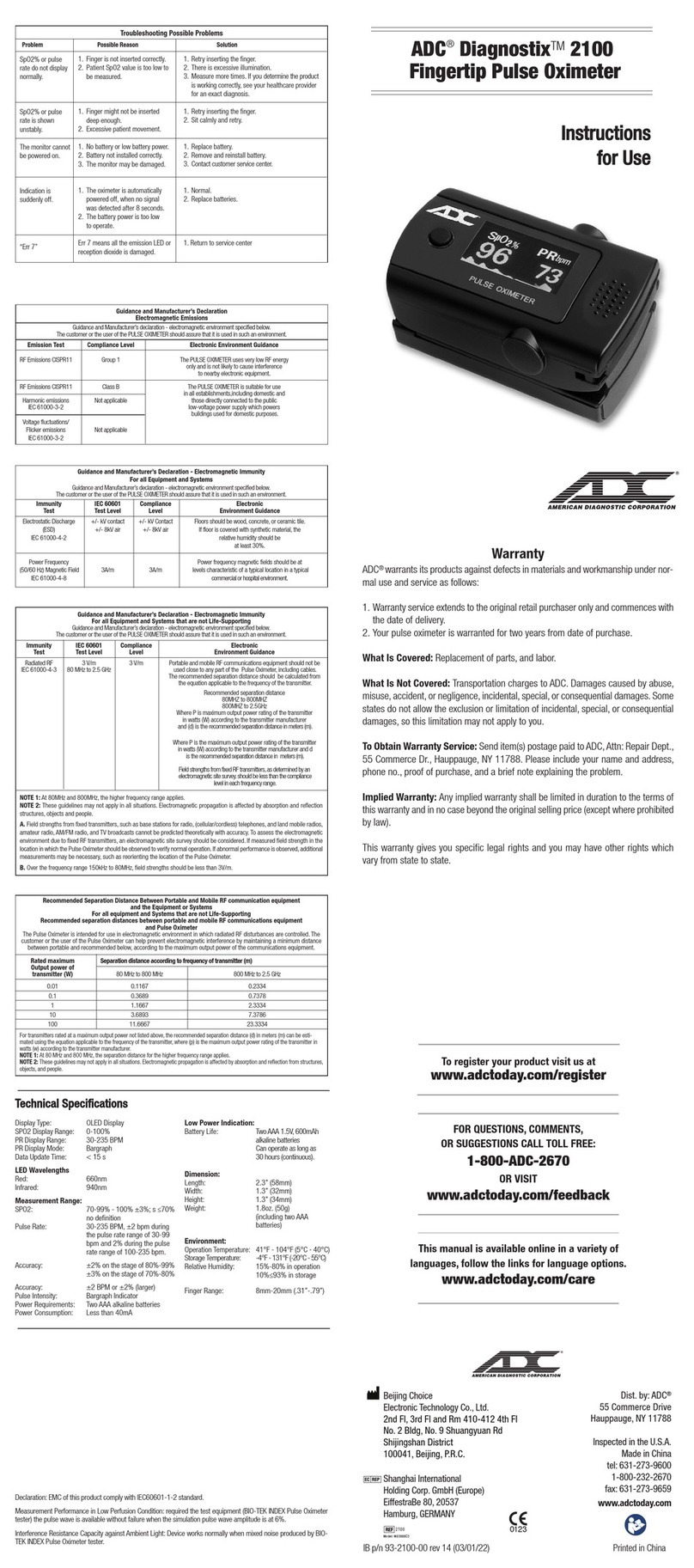MedaCure OCS5L User manual

、
SL Oxygen Concentrator
磷daCure
©2020 Made in China

Page 2
Table of Contents
1. SAFETY NOTES................................................................................ 4-6
1.1 Important Information ............................................................ 4
1.2 Before Installation ...................................................................4
1.3 Placement................................................................................4
1.4 Fire and Explosion Warning.....................................................5
1.5 Maintenance ...........................................................................5
1.6 Radio Frequency Interference ................................................5
1.7 Reduce the Risk of Burns ........................................................6
2. FEATURES ........................................................................................ 7-8
2.1 Summary .................................................................................7
2.2 Characteristics ........................................................................7
2.3 Specications ...................................................................... 7-8
3. HANDLING...........................................................................................9
3.1 Unpacking ...............................................................................9
3.2 Inspection ...............................................................................9
3.3 Storage ...................................................................................9
4. INSTALLATION AND OPERATION............................................... 10-13
4.1 Feature View .........................................................................10
4.2 Preparation ............................................................................11

Page 3
Table of Contents
4.3 Starting Up.............................................................................11
4.4 Alarm Signal .........................................................................12
4.5 Alarm Signal Cue ..................................................................12
4.6 Turning Off ............................................................................12
4.7 Symbols and Descriptions ....................................................13
5. MAINTENANCE ........................................................................... 14-15
5.1 Cleaning the Cabinet ............................................................14
5.2 Cleaning & Replacing the Filter ............................................14
5.3 Cleaning the Optional Humidier Bottle ..............................15
5.4 Oxygen Nasal Cannula .........................................................15
5.5 Tube Maintenance .................................................................15
5.6 Notes For Every New Patient ................................................15
6. TROUBLESHOOTING .................................................................. 16-17
7. OTHER ATTENTIVE ITEMS........................................................... 18-21
7.1 Post-Marketing Service .........................................................18
7.2 Treatment of Waste and Residual .........................................18
7.3 Accessories and Spare Parts .................................................18
7.4 EMC Guidance in Use...................................................... 19-21
COMPANY CONTACT INFORMATION ................................................22

Page 4
1. Safety Notes
WARNING: Users who require continuous oxygenation must plan for alternate reserve sources of power
and oxygen in the event of a failure or loss of power and oxygen. This device is to be used as an oxygen
supplement .and is NOT considered life-supporting or life-sustaining!
SYMBOLS CONTENTS
Describes the principal RISK(S) foreseen (e.g. “Causes burns”, “Risk of explosion”, etc.).
Describes what is prohibited (e.g. “Do not open”, “Do not drop”, etc.).
Describes required action (e.g. “Wear protective gloves”, “Scrub before entering”, etc.).
1.1 IMPORTANT INFORMATION
Risk of electric shock.
DO NOT disassemble. Refer servicing to a qualied service personnel.
DO NOT modify this equipment without authorization from the manufacturer.
Read the following information before operating this product.
1.2. Before Installation
The concentrator should always be kept in the upright position to prevent damage during transport.
If the electrical power source becomes unstable, discontinue use and nd an alternate source.
Only use stable and safe electrical power sources.
The oxygen concentrator cabinet should ONLY be opened by an authorized authorized equipment provider.
1.3 Placement
You may select a room in your house where using your oxygen concentrator would be most convenient. Your
concentrator can easily roll from room to room on its casters.
Do not place the oxygen concentrator in surroundings where airow is obstructed.
Be certain to place the oxygen concentrator in a position where all sides are at least 4 inches (10 cm) away from
walls, draperies, furniture, or similar surfaces. Avoid deep pile carpets and heaters, radiators or hot air registers.

Page 5
1. Safety Notes
Do not place the unit in a conned area.
The oxygen concentrator MUST be kept away from heat, re and excessive water sources and conditions.
The oxygen concentrator should be located in an area so as to avoid pollutants or fumes.
Do Not place any items on top of the concentrator.
NEVER block the air openings of the unit or place it on a soft surface, such as a bed or couch, where the
concentrator may tip or fall. Keep the openings free from lint, hair and the like.
1.4 Fire Warning and Explosion
Keep the concentrator away from ammable and explosive areas.
Users MUST NOT SMOKE while using this device. Keep all matches, lighted cigarettes or other sources of ignition
out of the room in which this product is located. NO SMOKING signs should be prominently displayed. Textiles and
other materials that normally would not burn are easily ignited and burn with great intensity in oxygen enriched air.
Failure to observe this warning can result in severe re, property damage and cause physical injury or DEATH.
The use of oxygen therapy requires that special care be taken to reduce the risk of re. Any materials that will
burn in air, and some that will not, are easily ignited and burn rapidly in high concentrations of oxygen. For safety
concerns, it is necessary that all sources of ignition be kept away from the product and preferably out of the room in
which it is being used.
A spontaneous and violent ignition may occur if oil, grease or greasy substances come in contact with oxygen
under pressure. These substances MUST be kept away from the oxygen concentrator, tubing and connections, and
all other oxygen equipment.
DO NOT use any lubricants unless recommended by manufacturer.
1.5 Maintenance
The oxygen concentrator should be maintained at the minimum once a year. Maintenance on this product
should only be done by the manufacturers authorized representative familiar with the operation and maintenance
of this device.
DO NOT service or maintain this device while in patient-use.
For optimum performance we recommend the concentrator be on and running for a minimum of 30 minutes at a
time. Shorter periods of operation may reduce maximum product life.
1.6 Radio Frequency Interference
Most electronic equipment is inuenced by Radio Frequency Interference (FRI). Always exercise CAUTION with
regard to the use of portable communications equipment in the area around such equipment.

Page 6
Energy of Radio Frequency of this machine is just for device operation use, so low Radio Frequency will not
affect the running of other electric equipment around regard to the use of portable communications equipment in
the area around such equipment.
1.7 To Reduce the Risk of Burns, Electrocution, Fire or Injury to Persons.
Avoid using this device while bathing. If continuous usage is required by the physician’s prescription, the
concentrator must be located in another room at least 8.2 feet (5.2 meter) from the bathtub.
DO NOT come in contact with the concentrator while wet.
DO NOT place or store this device where it may drop into water or other liquid.
DO NOT reach for this device if it has fallen into water. UNPLUG IMMEDIATELY and call an Authorized Service
Representative for examination and repair.
This device should NEVER be left unattended while plugged in.
This device is to be used only in accordance with the prescription of a physician and according to the directions
in this User Manual. If at any time the patient or attendant concludes the patient is receiving an insufcient amount
of oxygen, contact the provider and/or physician immediately. No adjustments should be made to the ow rate
unless prescribed by a physician.
Extra supervision is necessary when this device is used near children or physically-challenged individuals.
Use this device only for intended use as described in this manual.
DO NOT use parts, accessories or adapters other than those authorized by the manufacturer.
DO NOT use certain humidiers and administration accessories not specied for use with this oxygen
If replacement parts used for the periodic servicing by an approved technician do not comply with the
manufacturer’s specications, the manufacturer is not liable in the event of an accident.
DO NOT connect the concentrator in parallel or series with other oxygen concentrators or oxygen therapy devices.
In certain circumstances oxygen therapy can be hazardous. It is recommended that you seek medical advice
before using this product.
Avoid creation of any spark near medical oxygen equipment. This includes sparks from static electricity created
by any type of friction. If the concentrator has a damaged cord or plug, is not working properly and/or has been
dropped or damaged, please call an Authorized Service Representative for examination and repair.
Keep the cord away from HEATED or HOT surfaces.
Do not move or relocate the concentrator by pulling on the cord.
NEVER drop or insert any object into any opening.
1. Safety Notes

Page 7
2. Features
2.1 Summary
The Medacure oxygen concentrator is intended for individual use as an oxygen supplement device in a home
or care facility. The patient is an intended operator. It is an electronically operated device that separates oxygen
from ambient air. It provides high concentration of oxygen directly to the user through a nasal cannula or other
method.
2.2 Characteristics
•The oxygen concentrator is composed of a mainframe, humidier and ow meter
•A complete plastic outer shell,that is reliable & safe.
•The display screen shows the total elapsed working hours.
•The pressure safety valve helps ensure operating pressure.
•Power loss alarm function.
•High and low pressure alarm function.
•Low oxygen concentration alarm function.
•Heat protection to ensure the safety of the compressor and concentrator.
2.3 Specications
1. Power supply: AC120V, 60Hz; Current:3.5A; Power: 390VA
2. Sound level: ≤ 50dB (A)
3. Maximum Recommended Flow: 5L/min
4. Flow Range at Outlet Pressure of zero: 0.5~5L/min
Flow Range at Outlet Pressure of 7kPa: 0.5~5L/min
Change in maximum recommended flow when back pressure of 7kPa is applied: < 0.5 L/min
5. Oxygen Concentration : When 0.5~5L/min ,93%±3% (after the device is running for 5 minutes)
6. Output Pressure : 38kPa±5kPa
7. Release Pressure by machine operation : 250kPa±50kPa
8. Weight: 35.5 lbs. / 16.1 kg.
9. Dimension: 13” x 10” x 21” / 330×260×540 mm
10. Height above Sea Level: The oxygen concentration will not decrease at 6,000 feet (1,828 meter) height above sea
level. From 6,000 feet to 13,123 feet (1,828 meter to 4000 meter), the efficiency will decrease to less than 90%

Page 8
2. Features
11. Safety System:
•Current overload or line surge shutdown.
•High temperature compressor shutdown.
•High pressure alarm shutdown.
• Low Pressure larm shutdown.
• Low Oxygen Concentration alarm.
12. Minimum Operating Time: 30 minutes
13. Electric Classification: Class II equipment , Type BF applied part (Nasal oxygen cannula);
14. Mode of Operation: Continuous duty
15. Normal Operating Ambient:
1. Temperature Range: 41°F~104°F / 5°C~40°C
2. Relative Humidity: ≤80%
3. Atmospheric pressure: 12.47psi~15.37psi / 86kPa~106kPa
NOTE: 1. When the storage temperature is lower than 41°F / 5°C, the equipment should be placed in a normal
operation temperature environment for at least 4 hours.
2. The life time & efciency of the equipment will be affected and lowered if the equipment runs under
conditions exceeding normality.
16. Oxygen Output Temperature: Less than Ambient 43°F / +6°C
17. Tube: To prevent folding of tube, nasal oxygen should be 6.5 feet /2 meters and the prolonged tube should
not be longer than 50 feet/ 15.2 meters (no flatting).
18. The Storage and transport Ambient:
1. Temperature Range: 32°F~+131°F / 0°C+55°C
2. Relative Humidity Range: 10%~90%
3. Atmospheric Pressure: 10.2psi~15.37psi / 70kPa~106kPa
NOTE: The oxygen concentrator should be stored in an area without eroded gas.
Avoid shaking and inverting the concentrator when transporting.

Page 9
3. Handling
3.1 Unpacking
NOTE: Unless the oxygen concentrator is to be used immediately, retain containers and packing materials for
storage until concentrator is in use.
•Check for any obvious damage to the carton or its contents. If damage is noted, please notify the carrier
or local dealer immediately.
•Remove all loose packing from the carton.
•Carefully remove all components from the carton.
3.2 Inspection
•Examine exterior of the oxygen concentrator for nicks, dents, scratches or other damages.
•Carefully inspect all components.
3.3 Storage
•Store the repackaged oxygen concentrator in a dry area.
•DO NOT place anything on top of the repackaged concentrator.

4. Installation & Operation

Page 11
4. Installation & Operation
DO NOT add water above the maximum water level. Pure water shall be added in humidier between the
maximum and minimum water level in use.
•Power switch ——I indicates that the power is on. O indicate the power is off.
•If power is lost while the oxygen concentrator is on it will not run and the alarm will sound.
•The oxygen is obtained by passing through the humidier. Pure water should be added to the humidier.
When the tube of oxygen exits the humidier, the pressure in the humidier will ascend to 25±5kPa and
the safety valve of the humidier will open to release the pressure.
Inspection of humidier performance:
1. Use the PVC soft tube to connect the humidier adapter to the oxygen outlet
2. Turn on the oxygen concentrator and adjust the ux to about 5L/ min. Jam the exit of humidier and after
about 5 seconds the safety valve will open and the gas will release and the valve will close, which indicates
that the gas proong of the humidier and safety valve is conforming.
4.2 Preparation
•Unscrew the cover of the humidifier. Fill the humidifier bottle between the maximum and minimum water
level lines with purified water (or distilled water). Screw the cover onto the humidifier bottle. (If needed,
add medication now to the water according to the physicians’s recommendations.)
•Screw the humidifier bottle absorption connector onto the cover of the humidifier, and insert the
humidifier to the elastic belt located on the left side of the unit. Connect the other end of the cannula to
the oxygen outlet.
•Plug in power supply. Ensure that the power switch is off. Plug the concentrator’s AC connector into the
power outlet.
4.3 Starting up the Concentrator
•Press the power switch to the“|”position. A green and yellow light will be displayed. This indicates that the
function of the device is normal. After about 1 second only the green light will remain on. After 4 seconds
the display screen of elapsed time meter shows total elapsed working hours.
•To properly read the flow meter locate the prescribed flow rate line on the flow meter. Next, turn the flow
knob until the ball rises to the line. Lastly, center the ball on the L/min. line as prescribed (Figure 3).
NOTE: Oxygenation times and ow rate ranges are established and prescribed by your physician.
FIGURE # 3

Page 12
4. Installation & Operation
4.4 Alarm Signal
•Initial Startup of the Concentrator
NOTE: Concentrator may be used during the initial start warm-up time (approximately 30 minutes), while
waiting for the O2 concentration to reach maximum.
When the unit is turned on the green light will appear (O2 concentration greater than 82%±3%). After 5
minutes, the oxygen sensor will operate normally and will control the indicator lights depending on the
oxygen concentration values.
4.5 Alarm Signal cue
1. O2 concentration is greater than 85%±2%. Green light illuminates. Normal Operation.
2. O2 concentration is greater than 73%± 2% and less than 85%±2%. Yellow light illuminates.
3. O2 concentration is less than 73%±2%. Red light illuminates and intermittent audible alarm sounds.
4.6 Turning the Concentrator Off
Press the power switch to the “ O ” position and unplug the concentrator’s AC connector from the power
outlet. Use the plug device to isolate the concentrator from the supply mains.
CAUTION: If the ow rate on the ow meter falls below 0.5L/min, check the tubing or accessories for
blocked or kinked tubing and check for a defective humidier bottle.

Page 13
4. Installation & Operation
4.7 Symbols and Descriptions
SYMBOL MEANING SYMBOL MEANING
~
Alternating Current
Class II Equipment Type BF Applied Part
O
OFF (power) |ON (power)
Circuit Breaker
No Open Flame; Fire, Open
Ignition Source & Smoking
Prohibited
Height
Serial Number Date of Manufacture
Up Manufacturer
Keep Dry
Fragile, Handle With Care Atmospheric Pressure
Limitation
It is mandatory to read and Understand
the operating instructions prior to use.
This symbol has a blue background on
the product label.
LOT Number
Consult instructions
for use
Storage ambient temperature
Range 0 to 55℃
(+32℉ to 131℉)
Indicates amedical device
that has not been subjected
to a sterilization process.
This device contains electrical and/or electronic equipment that
must berecycled per EUDirective 2012/19/EU-Waste Electrical
and Electronic Equipment (WEEE)

5. Maintenance
0

Page 15
5.3 Cleaning the Optional Humidier Bottle
•Change the water in the humidier bottle every day.
•Cleaning: Wash the humidier bottle weekly. Use household detergent to wash. Then rinse under running
water and dry.
•Disinfect: Disinfect the humidier parts by immersing them in a disinfectant, or 1 part diluted vinegar with
10 parts water. Then rinse under running water and dry.
•Disassembly humidier bottle.
1. (1) Unscrew the humidifier bottle. (Figure 6a)
2. (2) Remove tube and its terminal filtration. (Figure7)
5.4 Oxygen nasal cannula (Available accessories)
Follow the nasal cannula manufacturer’s instructions.
5.5 Tube maintenance
It is recommended to maintain/replace the internal tube once
a year.
5.6 Note - For Every New Patient:
Follow the instructions from the humidier manufacturer.
The cabinet air lter should be washed or replaced.
The entire oxygen administration circuit (oxygen therapy nasal cannula, etc.) must be changed
FIGURE #6aFIGURE #7
Intake filter: The intake filter access door is located on the left side of the concentrator. Using a small
screwdriver, open the access door. Unscrew the block of cabinet filter holder. Remove the intake filter. (Figure 6)
It is recommended to replace with a new Intake filter every 2,000 hours.
More frequent inspection and replacement of filter may be required if operating concentrator in a dusty
environment.
The intake filter cannot be cleaned and can only be replaced.
5. Maintenance
FIGURE # 6

Page 16
6. Troubleshooting
Troubleshooting Guide
SYMPTOM PROBABLY CAUSE SOLUTION REMARK
Elapsed time meter
displays, the green and
the yellow light, but
the oxygen
concentrator stops
running immediately
and has a continuous
buzzer.
1) Four corns plug-in of
the valve has not been
inserted completely
1) Check and connect
the circuit board to
the valve’s fourcorns
plug-in.
2) Exhaust sound buffer
box jammed. 2) Replace it
3) Can’t open the valve. 3) Replace it
4) Failure of the main
electronic control circuit
board.
4) Replace it
The nasal cannula has
more mirage or blobs.
1) It won’t ventilate
completely around the
machine and the
operating temperature
is too high.
1) Make sure the
device is at least 4” /
10 cm away from the
wall, other obstruction
or heater.
Repair by an
authorized
representative only
2) Fan inside the
machine can’t run or
running rate turns slow,
making the operating
temperature too high.
2) a. Take out the
winker that locks
the fan.
2) b. Replace it.
Repair by an
authorized
representative only
3) Temperature of the
water added to
humidier bottle is too
high.
3) Add cold waterin
bottle.
4) There is too much
water added to the
humidier bottle.
4) Water added should
between the maximum
and minimum of the
liquid levels.

Page 17
SYMPTOM PROBABLY CAUSE SOLUTION REMARK
Concentrator works,
but yellow light
illuminates.
1) Concentrator’s
oxygen concentration
is safe, but decreasing.
1) Clean or Replace
lters.
2) Unit overheating
due to blocked air
intake.
2) Move concentrator
at least 10 cm (4
inches) away from
walls, draperies,
furniture, or similar
surfaces.
3) If condition persists, OK to continue use, but contact Equipment Provider
immediately.
Concentrator doesn’t
work, red light
illuminates, continuous
audible alarm sounds.
1) Low pressure alarm. 1) Clean or Replace
lters.
2) If condition persists, discontinue use, contact Equipment Provider immediately.
Concentrator doesn’t
work, red light
illuminates, continuous
audible alarm sounds.
High pressure alarm. Contact Equipment
Provider immediately.
Concentrator doesn’t
work, continuous
audible alarm sounds.
Compressor open
circuit alarm.
Contact Equipment
Provider immediately.
Concentrator doesn’t
work, continuous
audible alarm sounds.
Compressor short
circuit alarm.
Contact Equipment
Provider immediately.
6. Troubleshooting
NOTE: If you experience a problem with your concentrator and require an authorized equipment representative to service
or repair the device, contact the dealer or equipment provider from whom you purchased the concentrator.

Page 18
DO NOT service or conduct maintenance while in patient-use. The concentrator does not require extra
approved maintenance. The unit is equipped with a pressure and oxygen purity self-check function. However,
regular maintenance should be performed annually. Do not place the concentrator in a dusty location.
5.1 Cleaning the Cabinet
Clean the cabinet at least once a month.
•Turn off the power switch and unplug the concentrator’s AC connector from the power outlet.
•Clean ONLY the outside of the concentrator. Use a soft, dry cloth, a damp sponge or alcohol solution
based wipes. Do not use acetone, solvents or any other inammable products. Do not pour liquid into the
cabinet. This may damage the unit and void the warranty.
5.2 Cleaning or Replacing the Filter (3 Types)
Clean and replace the lters as outlined in the following paragraphs in order to protect the compressor and extend
the concentrator’s life.
DO NOT operate the concentrator without the lters installed or when lters are wet. These actions could
permanently damage the concentrator and void the warranty.
• Disassembly
1. Transom Filter: The Transom lter needs to cleaned every 2 weeks. (Figure 4)
2. Intake lter: The Intake lter needs to cleaned every 2 weeks. (Figure 5)
7. Other Attentive Items
7.1 Post-marketing Service
•With normal use and under normal maintenance circumstances if the Oxygen Concentrator can not
be normally used in half a year since delivery date, or in a year of commerce storage compressor, the
company is responsible for the free repair or exchange. If it can not be normally used in half a year, user
can contact the post-sales service department, ofce or agents for repair. If it can not be normally used
after one year, the company can provide accessories and repair with reasonable charges
•The following cases is not in the scope of the repair guarantee:
1. Damage of distortion of the integral equipment caused by collision; :
2. Water or rain entering integral equipment;
3. Equipment out of gear caused by water and drug;
4. Parts or accessories that are easily damaged due to wear and tear; grade I ltration net, ltration
carpet; damping lter, damping tube.
7.2 Treatment of Waste
The treatment of waste shall conform with federal and state laws
and regulations. The change of electric circuit and appearance caused by
improvement of equipment will not be informed.
7.3 Accessories and Spare Parts
The accessories used with this device must be oxygen compatible and be bio compatible.
NOTE: The connectors, tubes, nasal cannula or masks must be designed for oxygen therapy use. Included in the
set of accessories supplied with this device are items that comply with these requirements. Contact your dealer to
obtain these accessories.
List of accessories:
•Humidifier bottle 1 Set
•Connection tube of humidifier bottle 1 Set
• User manual 1 Set

Page 19
7. Other Attentive Items
7.4 Electric and Magnetic Environment Guidance for Use
GUIDANCE AND DECLARATION OF MANUFACTURER - ELECTROMAGNETIC IMMUNITY
The Medacure Oxygen Concentrator is intended for use in the electromagnetic environment specied below. The
customer or the user of the Medacure Oxygen Concentrator shouldassure that the unit is used in such an environment.
IMMUNITY IEC 61000-4-2 TEST
LEVEL COMPLIANCE LEVEL
ELECTROMAGNETIC
ENVIRONMENT-
GUIDANCE
Electrostatic discharge
(ESD)
IEC 61000-4-2
±6 kV contact discharge
±8 kV Air
discharge
±6 kV contact
discharge
±8 kV Air
discharge
Floors should be wood,
concrete or ceramic tile. If
oors are covered with
synthetic materials, the
relative humidity must be
at least 30%
Electrical fast transient
/bursts IEC
±2 kV for power
supply lines
±1 kV for
input/output
±2 kV for power
supply lines
Main power quality
should be that of a typical
commercial or hospital
environment.
Surge IEC
61000-4-5
±1 kV differential mode
±2 kV common
±1 kV differential mode
±2 kV common
Main power quality
should be that of a typical
commercial or hospital
environment.
Voltage dips, short
interruptions and Voltage
variations on power
supply input lines
IEC 61000-4-11
< 5%UT
(>95 % dip in UT)
< 5%UT
(>95 % dip in UT)
Main power quality
should be that of a typical
commercial or hospital
environment. If the user of
the Medacure Oxygen
Concentrator requires
continued operation
during power mains
interruptions, it is
recommended that the
Medacure Oxygen
Concentrator be powered
from an interruptible
power supply or a battery
40 % UT (60 % dip in UT)
for 5 cycle
40 % UT (60 % dip in UT)
for 5 cycle
70 % UT (30 % dip in UT)
for 25
70 % UT (30 % dip in UT)
for 25
<5 % UT (95 % dip in UT)
for 5 sec
<5 % UT (95 % dip in UT)
for 5 sec
Power frequency
(50 Hz) magnetic
IEC 61000-4-8
3 A/m
Due to the fact that the EUT
contains no components
susceptible to magnetic
eld, it is deemed to fulll
the relevant immunity
requirement without
testing.
Power frequency magnetic
elds should be at levels
characteristic of a typical
location in a typical
commercial or hospital
environment.
Note: UT is the a.c. main voltage prior to application of the test level.

Page 20
7. Other Attentive Items
GUIDANCE AND DECLARATION OF MANUFACTURER - ELECTROMAGNETIC IMMUNITY
The Medacure Oxygen Concentrator is intended for use in the electromagnetic environment specied below. The
customer or the user of the Medacure Oxygen Concentrator shouldassure that the unit is used in such an environment.
IMMUNITY EC61000-4-2 COMPLIANCE
LEVEL
ELECTROMAGNETIC
ENVIRONMENT- GUIDANCE
directed HF
interference
acc. to IEC 61000-
4-6
Radiated RF IEC
3 Vrms
150 kHz to
80 MHz
3 V/m
80 kHz to
2.5 GHz
3 V
3 V/m
Portable and mobile RF communications
equipment should be used no closer to any part
of the Medacure Oxygen Concentrator, including
cables, or more than the recommended separation
distance calculated from the equation applicable to
the frequency of the transmitter.
Recommended separation distance:
d= 1.2 √P
d= 1.2 √P 80 MHz to 800MHz
d= 2.3 √P 800 MHz to 2.5GHz
Where P is the maximum output power rating
of the transmitter in Watt (W) according to
the transmitter manufacturer and d is the
recommended separation distance in meters
(m). Field strengths from xed RF transmitters as
determined by an electromagnetic site survey a
should be less than the compliance level in each
frequency range. Interference may occur in the
vicinity of equipment marked with the following
symbol:
NOTE 1 At 80 MHz and 800 MHz, the higher frequency rangeapplies.
NOTE 2 These guidelines may not apply in all situations. Electromagnetic propagation is affected by absorption
and reection from structures, objects and people.
a. Field strengths from xed transmitters, such as base stations of radios, (cellular/cordless) telephones and
land mobile radios, amateur radios, AM and FM radio broadcast and television broadcast, cannot be predicted
theoretically with accuracy. To assess the electromagnetic environment due to xed RF transmitters, an
electromagnetic site survey should be considered. If the measured eld strength in the location in which the
Medacure Oxygen Concentrator is used exceeds the applicable RF compliance level above, the Medacure Oxygen
Concentrator should be observed to verify normal operation. If abnormal performance is observed, additional
measures may be necessary, such as reorienting or relocating the Medacure Oxygen Concentrator.
b. over the frequency range from 150 kHz to 80 MHz, the eld strengths should be less than 3 V/m.
Table of contents
Other MedaCure Medical Equipment manuals
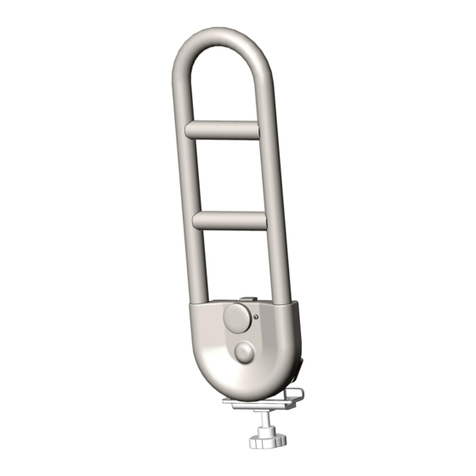
MedaCure
MedaCure PAB100-C User manual
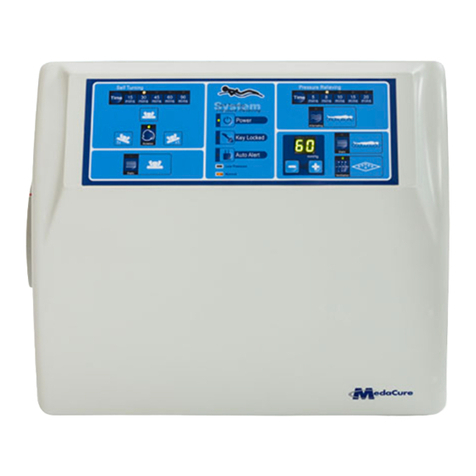
MedaCure
MedaCure Comfort Zone LRM36 User manual

MedaCure
MedaCure AirStream AS36 User manual

MedaCure
MedaCure DS1100 User manual
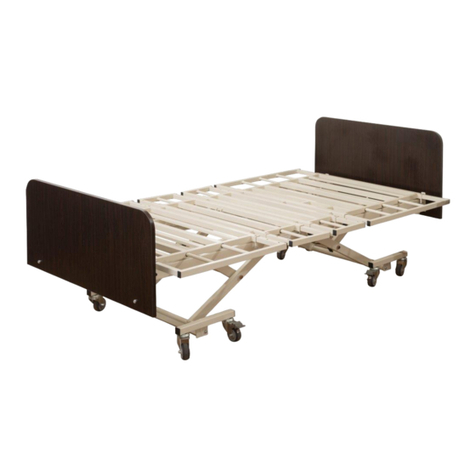
MedaCure
MedaCure LX-BARI User manual
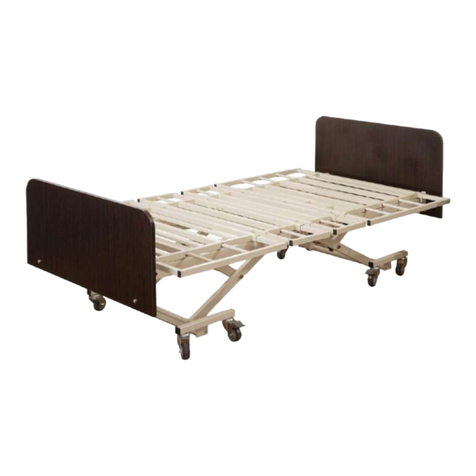
MedaCure
MedaCure LINCOLN LX-BARI Series User manual

MedaCure
MedaCure PD36 User manual
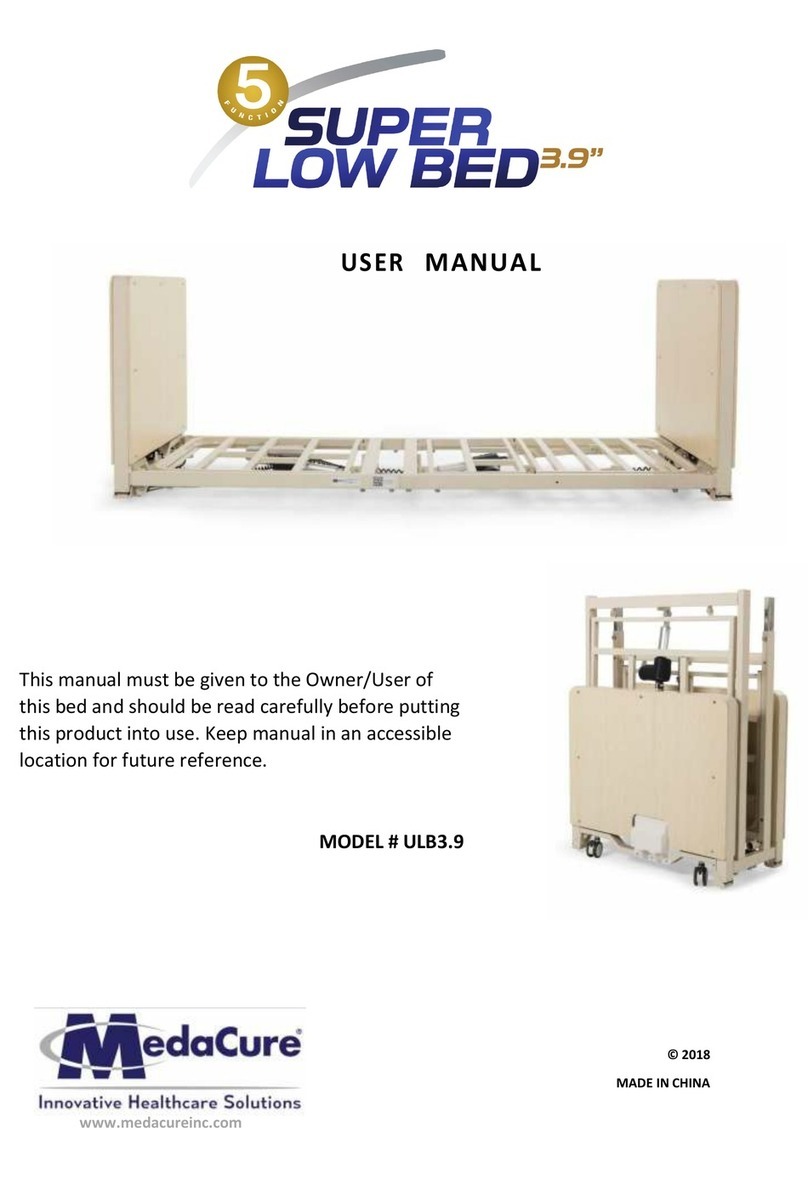
MedaCure
MedaCure SUPER LOW BED 3.9 User manual

MedaCure
MedaCure Air Wave AW7000 User manual
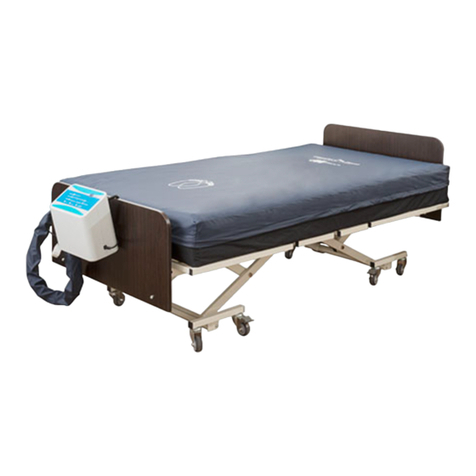
MedaCure
MedaCure CZ42 User manual
